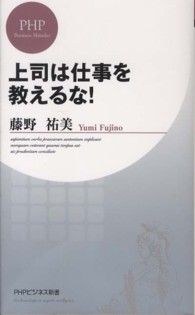Full Description
Drum Sound and Drum Tuning assists drummers, sound engineers, and music students in learning critical skills related to drum sound and achieving an optimised and personalised drum kit set-up. The book covers the essential theories of percussion acoustics and develops this knowledge in order to facilitate creative approaches to drum tuning and professional-level recording and mixing of drums.
All aspects of drumhead vibration, drumhead equalisation, and resonant drumhead coupling are de-mystified, alongside discussions relating to drumhead types, drum shell vibration, and tuning to musical intervals for different performance genres. The book develops drum sound theory and creative analysis into a detailed dissection of recording and production techniques specifically for drums, including discussions on studio technologies, room acoustics, microphone techniques, phase coherence, and mixing drums with advanced digital audio workstation (DAW) techniques and creative processing tools.
Drum Sound and Drum Tuning includes many practical hands-on exercises that incorporate example tutorials with Logic Pro and iDrumTune Pro software, encouraging the reader to put theory into immediate creative practice and to develop their own listening skills in an informed and reflective manner. The book also documents primary interviews and opinion from some of the world's most celebrated drummers, music producers, and sound engineers, enabling the reader to connect the relevant theories with real-world context, whilst refining their own personalised approach to mastering drum sound.
Contents
List of Figures
List of Tables
1 Introduction
1.1 Values of Great Drum Sound
1.2 Why Bother with Drum Tuning?
1.3 About this Book
1.3.1 Educational Approach
1.3.2 Online Resources
1.3.3 Interviews with Esteemed Professionals
1.3.4 Companion Software and Examples
1.4 Don't Forget to Listen!
2 Drumhead Vibration and the Science of Sound
2.1 Sound Sources, Acoustic Transmission and Sound Reception
2.2 Evaluating Frequencies
2.3 The Single Most Valuable Musical Acoustics Theory!
2.4 Measuring and Analysing Drum Modes
3 Tuning the Pitch of a Cylindrical Drum
3.1 Exploring the Pitch Range of a Cylindrical Drum
3.2 Musical Frequencies
3.3 Coupled Drumheads
4 Lug Tuning and Clearing the Drumhead
4.1 Evaluating the First Overtone of a Drum
4.2 Beat Frequencies
4.3 The Sound of a Uniformly Tuned Drumhead
4.4 Lug Tuning with Assistance
5 Tuning the Resonant Drumhead - What, Why and How?
5.1 Harmonics and In-Harmonic Overtones
5.2 Musical Intervals
5.3 Controlling Overtones and Intervals with the Resonant Drumhead
6 A Holistic Approach to Drum Tuning
6.1 Simplicity Wins
6.2 Setting the Fundamental Pitch
6.3 Implementing Lug Tuning and Resonant Head Tuning
6.4 Damping and Decay Times
7 The Wonderful World of Drumheads
7.1 Guitar Strings on Steroids!
7.2 The Drumhead Equation
7.3 Drumhead Types and Features
7.4 Resonant Drumhead Selection
7.5 Experience Drumheads!
8 Timbre: The Truth about Drum Shell Vibration
8.1 Introducing Timbre
8.2 Tuning Fork Example with Mass Loading
8.3 Drum Shell Vibration
8.4 Loading the Drum Shell
8.5 Bearing Edges and Precision Manufacturing
8.6 Considering the Drum Shell Vibration Frequency when Tuning
9 Tuning for Different Musical Styles and Genres
9.1 Creative Objectives
9.2 Drum Sizes for Different Music Genres
9.3 Pitches and Intervals on the Kit
9.4 Tuning Suggestions for Different Genres
9.5 Drumheads for Different Music Genres
10 Snare Drum Tuning
10.1 Key Aspects of Snare Tuning
10.2 Holistic Approach to Snare Tuning
10.3 Manipulating Snare Drum Timbre
10.4 Comparing Snare Timbre Example
11 Kick Drum Tuning
11.1 Kick Drum Tone and Dynamics
11.2 Drumheads for the Kick Drum
11.3 Kick Drum Tuning Range
11.4 Controlling the Kick Drum Timbre
12 Production and Preparation for Drum Recording
12.1 Production and Pre-Production
12.2 Setting Standards and Getting Results
12.3 Choosing and Evaluating the Recording Space
12.3.1 Room Size and Dimensions
12.3.2 Room Materials and Reverberation Characteristics
12.3.3 Sound Isolation and Background Noise Levels
12.3.4 Suitability for a Room's Use in a Recording Project
12.3.5 Positioning Drums within a Room
12.4 Tuning and Performance for Recording
13 Fundamental Technologies for Drum Recording
13.1 Microphones and Transducers
13.1.1 Dynamic Microphones
13.1.2 Condenser Microphones
13.1.3 Ribbon Microphones
13.1.4 Other Audio Transducers
13.2 Microphone Characteristics
13.2.1 Microphone Polar Patterns
13.2.2 Other Microphone Characteristics
13.3 The Complete Recording Signal Chain
13.3.1 Audio Convertors
13.3.2 Mixing Desk
13.3.3 Microphone Preamplifiers
13.3.4 Recording with FX
13.4 Monitoring and Foldback
13.4.1 Control Room Monitoring
13.4.2 Headphone Foldback
14 We Need to Talk About Phase!
14.1 What Exactly is Phase?
14.2 Time Delay and Comb Filtering
14.3 Mono Compatibility
14.4 Signal Polarity
15 Microphone Techniques for Recording Drums
15.1 Microphone Placement Approaches
15.2 Stereo Recording for Drums
15.2.1 Defining The Stereo Field
15.2.2 Spaced Pair Technique
15.2.3 X-Y Technique
15.2.4 Blumlein Pair Technique
15.2.5 ORTF Technique
15.2.6 Mid-Side Technique
15.2.7 Baffled Omnidirectional Pair Technique
15.2.8 Decca Tree Technique
15.2.9 Left-Right-Center Technique
15.3 Using Spot Microphone Techniques
15.3.1 Kick Drum Microphone Technique
15.3.2 Snare Drum Microphone Technique
15.3.3 Tom Drum Microphone Technique
15.3.4 Close Cymbal Microphone Technique
15.4 Room Microphones
15.5 Microphone Choices for Recording Drums
15.6 Developing a Personal Approach
16 Mixing Drums: Balance and Dynamics
16.1 Balance, Panning and Bussing
16.2 Dynamics Processing
16.2.1 Compression and Limiting
16.2.2 Gates and Expanders
16.2.3 Envelope Shaping
16.3 Hybrid mixing
17 Mixing Drums: Creative Processing
17.1 Equalisation and Spectral Processing
17.1.1 Cutting Low Frequencies
17.1.2 Treating the Fundamental and Overtones of Each Drum
17.1.3 Adding Attack and Presence
17.1.4 Controlling High Frequencies
17.2 Using Reverb to Regain Authenticity
17.3 Delay for Drums
17.4 Distortion and Enhancers
17.5 Sequential and Sidechain and Processing
17.6 Drum Replacement
17.7 The Final Mixdown
Index







